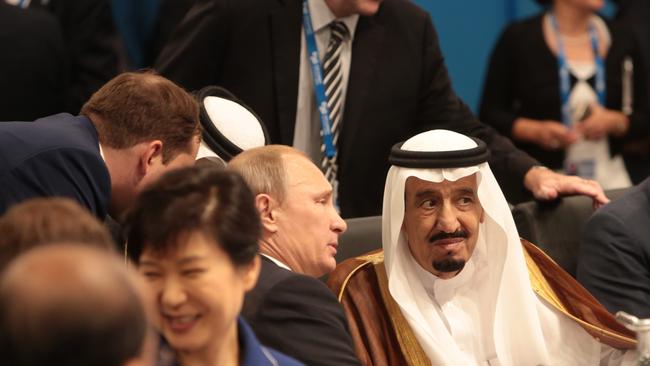Oil deals keep slipping through OPEC’s fingers

In effect, the market concluded that the co-operation agreement, which includes the establishment of a working group between the world’s two largest producers, was not that much different to the succession of failed attempts to agree to freezes or caps on production that have been put forward ever since the oil price cracked in 2014.
The likelihood of the OPEC producers and those, like Russia, on its periphery agreeing to freezing or even reducing production at the informal OPEC meeting (which Russia will attend) in Algeria later this month is regarded as small — and irrelevant.
With the key producers, other than Iran and the Saudis, already producing at, or very close to, capacity, a freeze or cap at current levels wouldn’t alter the supply-demand levels.
The Saudis are pumping out crude at record levels (more than 10.5 million barrels a day already), while Iran is nearing the pre-sanctions levels it has targeted but still has a couple of hundred thousand barrels a day of production to go to achieve its objective of 4 million barrels a day and is most unlikely to agree to limiting output to anything less than that.
In the absence of actual production cuts, the glut of oil inventories and the gradual return of rigs to US onshore oilfields makes it unlikely that there will be any near term shift in the balance of supply over demand that has kept the oil price below $US50 a barrel.
It remains the case that, absent those cuts, the likelihood is that it will take until at least mid-2017 before the continuing growth in demand rebalances the market fundamentals and sees the price moving up meaningfully.
What the agreement between the Saudis and Russians does reflect is the stress these two years of low prices has generated for the major oil producers.
Russia’s generates about 70 per cent of its export income from oil and gas. The collapse in the price since 2014, when it was comfortably above $US100 a barrel, to below $US30 a barrel at the start of this year, has decimated the Russian economy, which contracted by 3.7 per cent last year and, according to the IMF, is likely to have shrunk another 1.2 per cent by the end of this year.
The rouble has lost over half its value relative to the US dollar — at once stage it was closer to 80 per cent — more than 13 per cent of its population lives below the poverty line and it runs among the highest interest rates in the developing world to try to control inflation and put a floor under its exchange rate.
After peaking at 17 per cent, Russia’s central bank’s benchmark rate is still 10.5 per cent.
While it is tempting to see the agreement between the Saudis and Russia as part of some grand Putin plan for Middle East dominance, the more obvious explanation is that Russia needs higher oil prices if it is to have economic and political stability.
Within OPEC, Venezuela, Algeria, Libya, Nigeria and Iraq have seen their public finances ravaged by the market-share strategy the Saudi-led OPEC embarked on in 2014, when the elevated oil prices saw the scale of the US shale oil and gas sector explode.
The Saudis are, thanks to their massive reserves, in a far different state, but nevertheless have run down their foreign exchange reserves by $US190 billion since 2014, have been forced to dramatically shrink government spending and have had to raise utility charges because of the loss of oil revenues.
The co-operation between the Saudis and Russians is consistent with Saudi statements ahead of most OPEC meetings in recent times, where it expresses interest in some form of production limitations — but insists that its support is conditional on its regional archrival, Iran, agreeing to a production freeze. After years of sanctions, Iran was never going to agree.
The Iranians are still about 200,000 barrels a day short of their pre-sanctions production levels, so the potential for some form of freeze — at, as indicated, record levels — is increasing.
The problem for the Saudis and OPEC is that a strategy that was supposed to decimate the US onshore oil industry (and perhaps slow the return of Iran as a major producer) hasn’t, two years later, quite turned out as planned. The US producers have shown themselves to be more resilient, and innovative, than anyone anticipated.
OPEC members are now talking about trying to orchestrate a rise in the oil price to within a range of $US50 to $US60 a barrel, with the upper limit pitched at a level they hope will keep a lid on US production.
It wasn’t long ago that the 2017 target was a price of around $US70 a barrel, but the unforeseen scale of the dramatic improvements in onshore extraction techniques and costs in response to the plunge in oil prices means there would be a major resurgence in US production at those price levels.
Indeed, anything much above $US50 a barrel would see US production start to come back and, indeed, the number of rigs operating in the US has been climbing steadily in recent months as the price has pushed up towards $US50 a barrel.
Ultimately, OPEC (which really means the Saudis) may have to decide between price and market share — and the loss of geopolitical strategic importance and influence that would be associated with ceding share back to the US domestic producers.
In the near term, however, without an unlikely agreement on actual production cuts by the Saudis and Russians, OPEC appears trapped in a destructive, wealth-sapping strategy with no easy exit options other than waiting for the effects of the massive reductions in oil industry exploration and development spending over the past two years to eventually be reflected in the underlying fundamentals of demand and supply.






The initial excitement over the G20 agreement between Saudi Arabia and Russia to co-operate in a bid try to stabilise the oil market started to evaporate overnight, as a more realistic assessment of the implications of the agreement started to emerge.